Motorsports Racing News & Blog Articles
2022 BMW R18B (And R18 Transcontinental) Review – First Ride
2022 BMW R18B
Editor Score: 83.0%| Engine | 16.5/20 |
| Suspension/Handling | 11.5/15 |
| Transmission/Clutch | 7.0/10 |
| Brakes | 7.5/10 |
| Instruments/Controls | 7.5/5 |
| Ergonomics/Comfort | 8.5/10 |
| Appearance/Quality | 9.5/10 |
| Desirability | 8.0/10 |
| Value | 7.0/10 |
| Overall Score | 83/100 |
As I pull the 2022 BMW R18B out of the underground parking of the hotel where BMW had hosted its new model introduction, I wonder if a 7:30 departure still qualifies as my crack-of-dawn goal. Within a couple of blocks, I’m fully embroiled in the peak Denver commuter bump-and-grind. Still, I settle into an easy rhythm of following the mechanical voice instructions paired with their informative visual counterparts on the massive TFT screen. The saddlebags are packed to the point of bulging, and the overflow gear is rolled up and strapped down on the back. Yes, I’d have more room with the BMW R18 Transcontinental, but I prefer baggers for their cleaner lines and lower weight. Eventually, I head up the entrance ramp that will guide me to I-70 W out of the city. When I roll the throttle open, accelerating up to cruising speed, the beefy Boxer shudders its approval. The mountains and the road west beckon.
BMW Releases Details On “Big Boxer” R18 Engine
2021 BMW R18 Review – First Ride
Fast FactsDrivetrain unchanged from original R18 Self-leveling rear ride height Adaptive cruise control Amazing TFT screen Phone-based navigation Tank holds 6.3 gallons for 304 mile calculated range MSRP: $22,590 (base)
A Big Boxer
Ignoring the ginormous cylinders jutting out of both sides of the “Big Boxer”engine is simply impossible. Nothing about the 1,802cc Big Twin is subtle. Take its 244-lb. weight, for example, which is about 13 lb. more than a Honda Grom. Or how about the 107 mm x 100 mm bore and stroke? Despite its historical origins, the air- and oil-cooled Big Boxer is a thoroughly modern, Euro 5-certified beast. The four valves per cylinder are operated by fork rocker arms (with traditional locking screw adjusters for easy home-garage adjustment), which in turn are manipulated by pushrods. The dual cams are positioned above the crankshaft to help minimize pushrod length and reciprocating mass and contribute to the overall tighter tolerances of a modern engine.
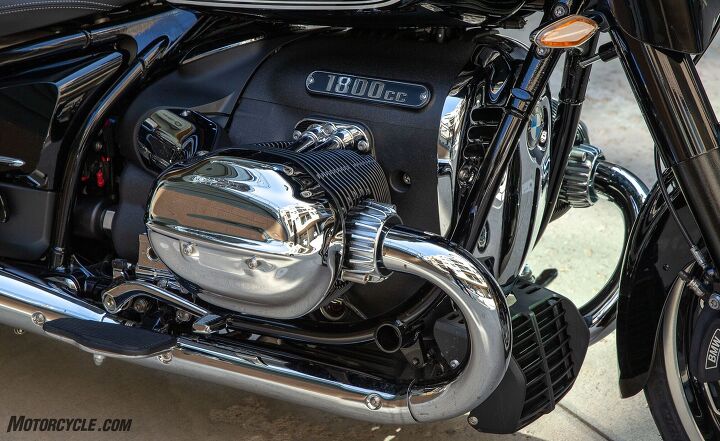
If you liked the R18’s Big Boxer engine but wanted some cargo carrying capacity, you got your wish.
Power is transferred from the engine to the exposed drive shaft via a constant mesh 6-speed transmission. Controlling the exchange of power is a single plate, self-reinforcing dry clutch, complete with a back-torque limiter to prevent rear wheel hop under hard deceleration or botched downshifts.
Working my way through the morning traffic is an object lesson in how clutch effort need not be hard on a torquey, large-displacement engine. My hand can easily manage the repeated clutch releases in the shuffle from one stoplight to the next. One feature that is not as sunny as this Friday morning is the clutch’s friction zone and final engagement point, which seems to vary with the throttle position. So, if I try to get a quick launch by giving a little more throttle, the clutch ends up slipping more, making me sound like I don’t know what I’m doing. The workaround I settle on is getting the clutch fully engaged while almost lugging the engine and then rolling on the throttle, which works quite well in traffic. Still, I’d prefer a more consistent clutch engagement point.
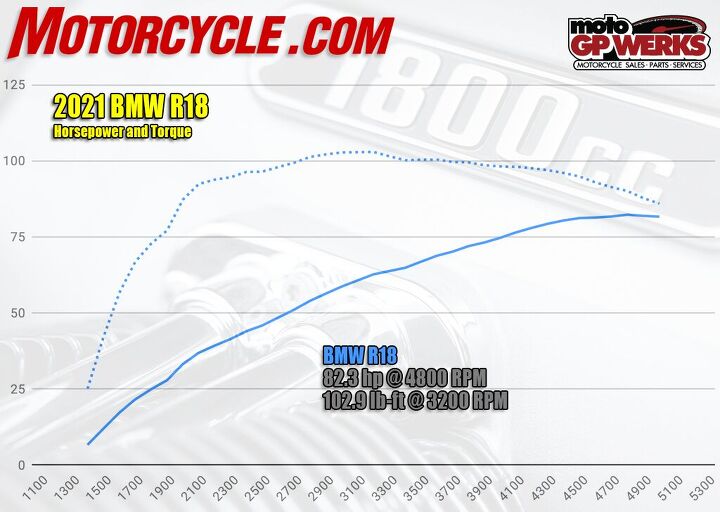
Since the R18B/Transcontinental have the exact same powertrain as the R18, the power output should be similar, if not the same, to the R18 we tested last year.
Once I enter the mountains and leave the interstate behind, I can really focus on the engine’s power delivery. The Big Boxer has a sweet spot between 2,000 rpm and 3,500 rpm, and if you can ride the crest of the torque wave here the engine seems its happiest. Get up above 3,500 rpm, and vibration becomes pretty prominent. Above 4,000 rpm you become acutely aware of how huge those pistons are as they slam back-and-forth inches from your feet. There was some discussion about engine vibration among the journalists, with some of them finding objectionable vibrations occurring below 3,500 rpm. Personally, I find that if you can keep the rpm within that 1,500-rpm range, the vibration is really quite pleasant and part of the character of a Big Twin. Try to rev out the engine to redline, and unless you are accelerating very quickly, the vibration becomes oppressive, particularly above 4,000 rpm.
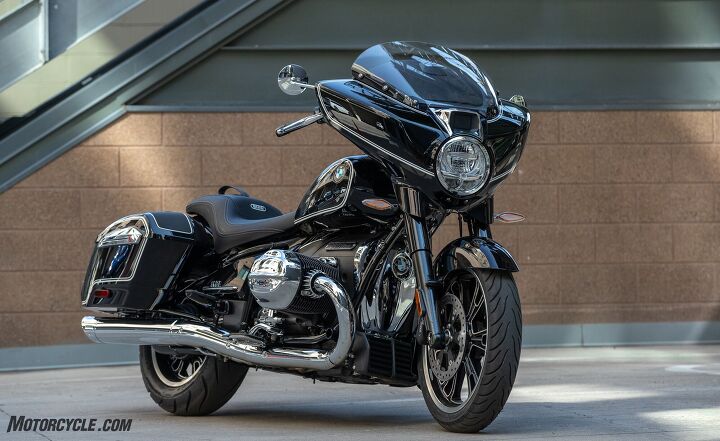
The BMW R18B checks most of the boxes of what creates an American-style bagger, and then it turns it on its ear.
Rolling through seemingly endless corners through the Rocky Mountains is a great way to test the EFI’s fuel metering. As I found with the R18 when I had one in my possession last year, the fueling is spot on. Nothing I could do would make the power delivery hiccup in any on/off or off/on throttle transitions. While I’m sure the flywheel effect helps to mask any small miscues, the overall impression is one of polished precision.
The same can be said of the slick-shifting transmission. Once I had the heel and toe shifters height adjusted to my preference, running through the gears was simply a joy. What makes the shifter adjustment so critical is that there is precious little space for the rider’s toes to access the shifter, and having the front shifter only slightly too high or too low makes shifting quite difficult. Still, on my journey through the Rockies, I frequently wondered why BMW chose not to outfit the R18B with its typically flawless Shift Assist Pro system. Given that the engine’s happy place is only 1,500 rpm wide, the rider has to stir the gearbox a little more frequently than is typically required of a Big Twin.
Updated Chassis
BMW could have simply installed the fork-mounted fairing and saddlebags without making any changes to the chassis (we’ve seen it done before), but that would have compromised the chassis rigidity and stability of the R18B and the R18 Transcontinental even more so. Consequently, the BMW engineering team tackled the chassis from two directions. First, the headstock and backbone were strengthened to handle the additional loads of the fairing, saddlebags, passengers, and cargo. More interestingly, the rake was changed, and the fork tubes were moved behind the steering stem. These changes were made to give the bike a lighter steering feel at lower speeds and to lessen the tendency to fall into corners at higher speeds.
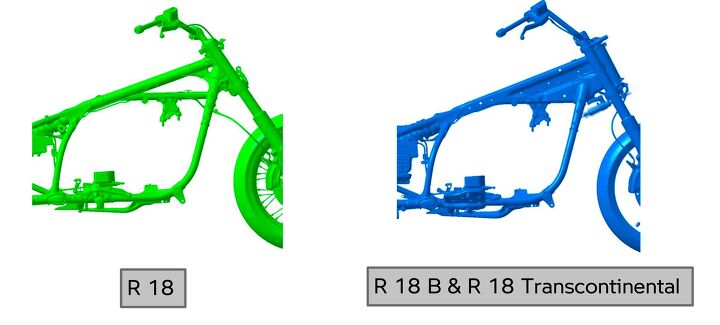
The difference between the two chassis constructions is pretty obvious from the rendering – and from the saddle.
BMW was successful in both goals. Once you get the R18B (and Transcontinental) moving, parking lot maneuvers are pretty sprightly for a machine claimed to weigh 877 lb. In my travels home from the Denver introduction, I bent the bagger into hundreds of corners and not once did I feel an inkling of falling in. Quite the opposite. The R18B wants to stand up slightly and understeer in corners, requiring a bit of pressure on the inside grip to hold a line. This is not to say that the rider has to fight the bike, and the tendency is not increased by rolling off the throttle or applying the brakes mid-corner. It’s just a characteristic that I noted and played around with throughout my ride, and it does not affect the ability to change lines mid-corner at all.
As my ride takes me out of Colorado and into the remote southeastern corner of Utah, I encounter bumpy pavement that gives me the perfect environment to consider the suspension and chassis stiffness. Having been spoiled by semi-active suspension, I miss it a bit on the rough pavement. The taut fork and shock that stabilize the chassis in corners feel a little harsh in this environment. However, given the choice between a firm ride in the corners with a little more delivery of bumps to the rider and a pillowy ride that wallows in the corners, I’ll take the firmer suspension every time. Despite the firmness, I can clearly feel the additional suspension stroke allowed by the 4.7-in. travel BMW claims in the rear. Where the R18 felt harsh as the shock ended its stroke, the R18B (and Transcontinental) does a better job of handling big jolts.
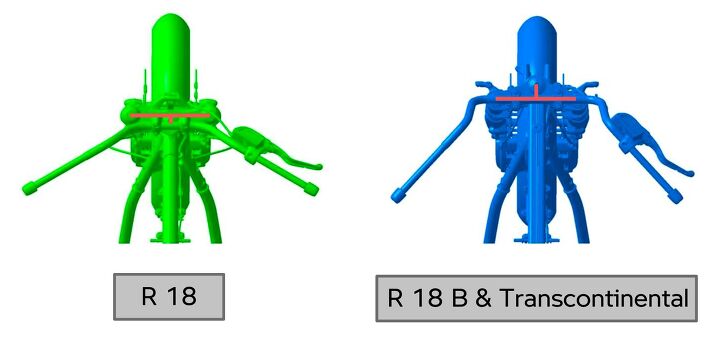
By putting the fork tubes behind the steering stem, BMW’s engineers achieved their goal of easy low-speed handling and ending the tendency to fall into corners (just like Harley-Davidson did 30 years ago).
Encountering bumps while leaned over, particularly in high-speed sweepers, is a great way to test the stiffness of the chassis, and in all but the biggest of the rolling bumps encountered mid-corner, the chassis displays no flex. Those big hits, which are followed by G-outs, give a slight, momentary hinge-in-the-middle feeling but not the oscillation that can turn into a wobble.
Not surprisingly, the limiting factor in cornering is the floorboards. While the shock is 1.2 in. longer, the ride-height only increased by 0.3 in. So, the R18B has marginally more cornering clearance and, like its older sibling, drags cleanly when the peg/floorboards do touch. Still, the cornering fun ends sooner than I like. However, by the time I arrive in Utah, I’ve had two days of riding to adjust my lean angle sensors and only drag the floorboard twice in the state while still having fun at a cruiser-touring pace and continuing to be the fastest bike of all those I encounter on the road.
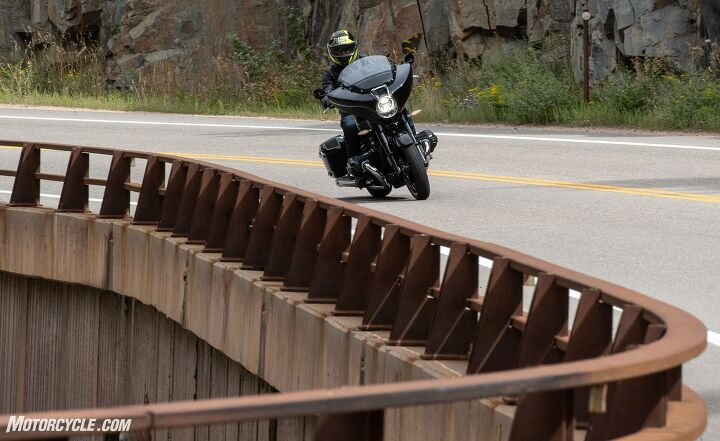
Capable Cruiser Brakes
I come up with this description of the R18B’s binders, as I’m trail-braking into a long, downhill, slightly decreasing-radius corner along Utah’s scenic Highway 12. The phrasing is meant to imply that, while they are decent, the brakes are not up to sporty-touring standards – not that it’s really a problem since the R18B is a cruiser. So, what we have is a pair of axial-mounted four-piston calipers squeezing 300mm floating rotors up front with a single four-piston caliper and 300mm disc out back to handle your deceleration requirements.
While the lever is mushier than I would like – and consequently, limits feel – the front braking system is plenty powerful and can haul the big bike down from speed with gusto if necessary. Notably, the brakes are linked, making the front brake also apply the rear brake to some degree. This is a good thing since the brake pedal position makes it difficult to cover or even apply the rear brake in a hurry. I can only guess that the position was an attempt to address the issue with the R18’s pedal. Unfortunately, the new location is a detriment to the rear brake’s use.
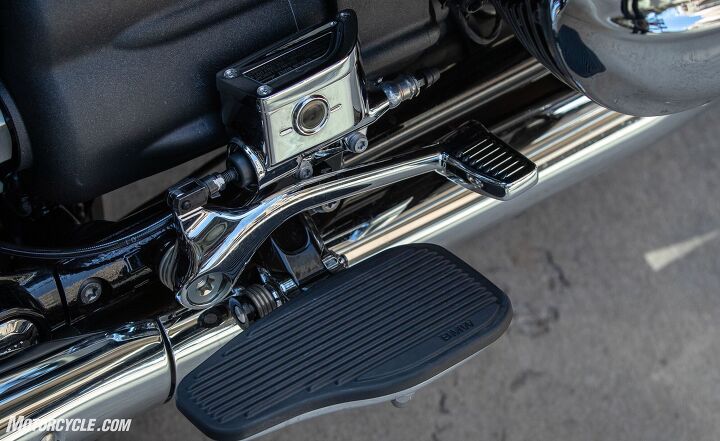
Although the clearance is tight with the right cylinder, I think that having the brake pedal be a half inch wider would address the rear brake application problem.
So, how does a performance-oriented rider navigate a turn on this touring cruiser? The long wheelbase means that the Big Boxer plays a big role on corner entry with an early throttle roll-off on approach and a possible downshift to begin the deceleration. When I choose to apply the brakes is a function of how I see the corner’s path. Typically, I lift to a neutral throttle position and trail the brakes into the corner using them to keep my lean angle within the ground clearance parameters. When the exit is in sight (or I’m certain my speed is correct for the rest of the corner), I release the brakes and begin the throttle roll-on. This technique is fun, challenging, and allows the R18B to make remarkably good time through a series of corners despite the ground clearance limitations.
Rider Comfort
The area of rider comfort is quite subjective. So, I believe I should start with some dimensions. I am 5 ft. 11 in. with a 32-in. inseam. At the R18B’s introduction, I encountered journalists – both taller and shorter than myself – that rated the riding position less than ideal. I’ll start with the legroom. I was riding 400-500 miles per day and never felt cramped by the floorboard position. However, I heard a rider who is a couple of inches taller than me say that the legroom was less than optimal for him. Similarly, he felt that the B’s windshield created excessive buffeting while I had no issues with it – even at triple-digit speeds.
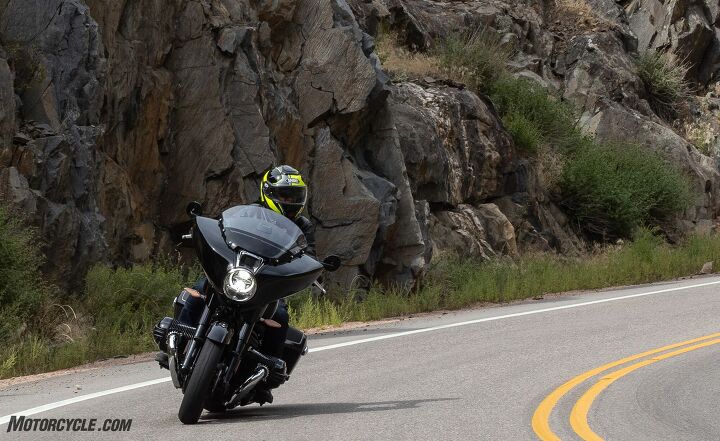
Although this windshield is the standard height for the R18B, the blacked out lower portion reveals it to be a BMW accessory version.
(An aside about the taller Transcontinental windshield: I was able to just barely see over it, with the line crossing the lower third of my field of vision, but a shorter rider of around 5 ft. 8 in. said he could only look through it, which would be a consideration for riders in rainy or buggy environments. Since the Bagger and Transcontinental windshields are interchangeable, the lower option would fit on the Transcontinental. There is also a wind deflector option that is even lower, but I did not get a chance to see or sample it.)
When traveling multiple hundreds of miles per day, any seat will get uncomfortable. That said, taking occasional breaks to stretch my legs and get fresh blood in my buttocks helped immensely. I’d rate the R18B’s seat at a solid 8 out of 10 for long-distance comfort. There is also plenty of room to move around on the seat to ease the bun burn during tank-draining stints.
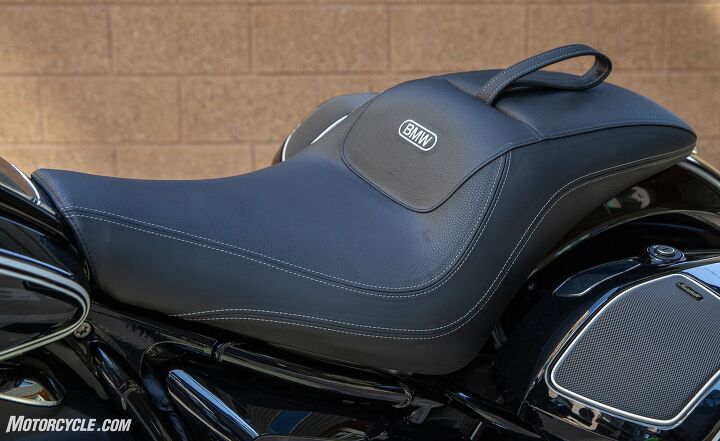
The R18B’s seat was as comfortable as any seat can be on a 500-mile day. Removing that annoying strap for the passenger would be the first change I’d make if I bought this bike.
With regards to my upper body, the reach to the handlebar was just about perfect for me, and only during tight turns did I feel like it was a stretch for my outer arm to retain a comfortable grip on the throttle, brake, or clutch.
Storage Capacity
The fact that the B has less storage capacity than the Transcontinental is fairly obvious, and both bikes offer a fairly typical saddlebag capacity of 27 liters. However, it was a single miscalculation (the hard sides of my helmet case made it take up half of the saddlebag’s space) that forced me to strap my duffel bag to the back seat for my ride home. The electronically-locking saddlebags feature an interesting double locking system. You press the lid down until it clicks, and then you press down a lever to secure the latch. The electric lock is also keyed for non-powered use. If I were in the market for this bike, I’d go for a version without the saddlebag speakers since they eat into the storage space, and I never use a motorcycle’s speakers unless I’m testing the sound system for an article.
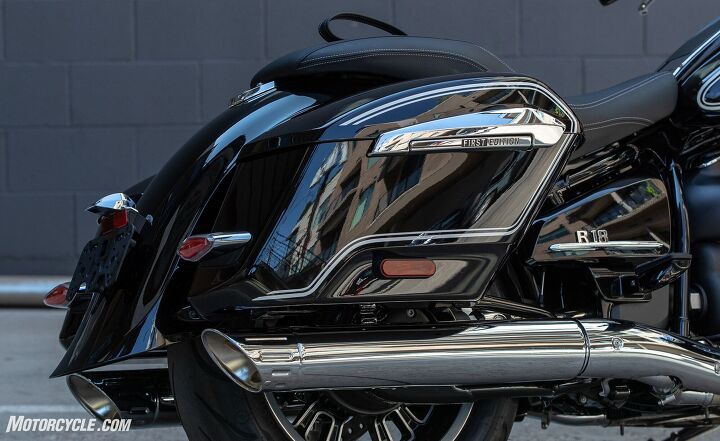
If you’re one of the types that wants to be able to remove your bagger’s bags for around town lightness, look elsewhere. The wiring harness for the tail lights, the electronic locks, and the optional speakers all exit the rear fender near the bag mounts.
Electronic Touring Amenities
Here is an area where BMW typically excels, and for the most part, this is true with the R18B and R18 Transcontinental. Many of the options, when they work properly, are completely unobtrusive and go unnoticed. For example the automatic ride-height adjustment on the shock. How do I know it worked? The R18B felt completely balanced front and rear both with and without my belongings in the saddlebags. Then there are the de rigueur heated grips and seat (the grips I used when summiting Mt. Evans in 42° F weather and 30-mph winds).
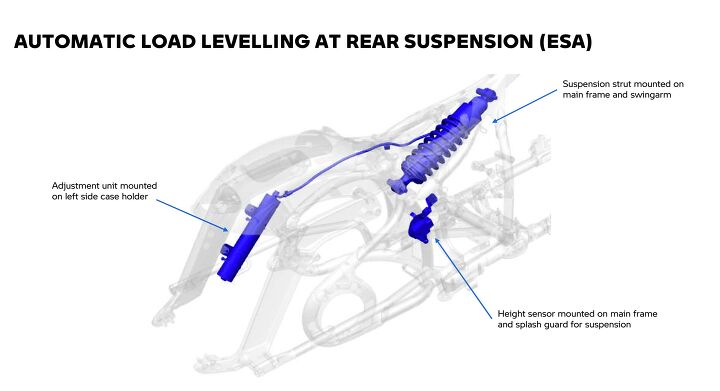
Here’s how the Automatic Load Leveling system works behind the scenes so that you don’t have to think about it.
Riding after dark to my hotel gives me a chance to really test the LED headlight. With the Headlight Pro with Mechanical Cornering Lights, I expected to be able to see a difference as I turned in for corners. Well, I don’t notice the low beam pivoting, but I am impressed by how far through a corner I can see after dark. BMW claims the low beam pivots over a range of +/- 35°. This is particularly important since I am riding through dusk to full darkness in the mountains…in open range…where 1,700 lb. of beef in a black fur coat could be awaiting me just out of the light’s reach. The high beam is impressive, giving me a great view down the road, but I’m even more thrilled by the low beam’s light pattern that gives plenty of illumination without prompting a single oncoming car to flash lights at me.
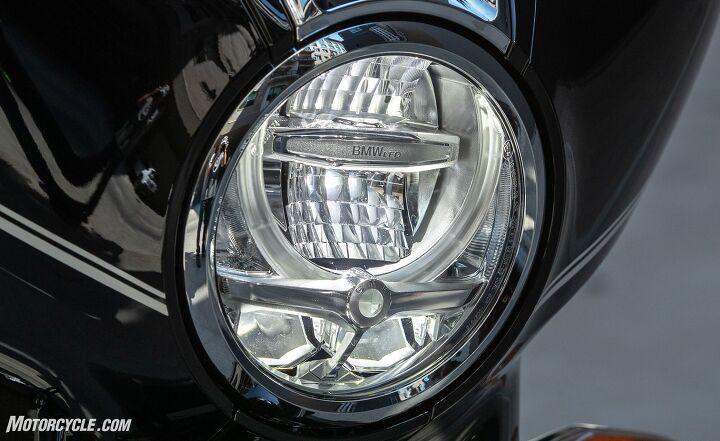
The LED headlight and its pivoting beam light up the road quite well at night.
Perhaps the most impressive piece of electronics in the R18B’s arsenal is the Adaptive Cruise Control. Not only does it take into account the vehicles in front of you, but it also responds almost immediately to climbing or topping a hill, typically delivering just 1 mph of variation when encountering these challenges. The more I play with the cruise control the more impressed I am with it, which is why I have it set to allow for the closest following distance possible. The front radar has a remarkably narrow beam and only selects the cars in your lane, although sometimes, in a curve, the car icon on the TFT will flash for an instant before correcting itself as the car in the next lane crosses the radar’s field of view. However, with a field of view this precise, it is possible for it to miss the bike immediately in front of you when riding in a staggered formation. Riding a little more towards the center of the lane, rather than the right or left side, eliminates this issue, but you still need to pay a little more attention with bikes in front of you than with other vehicles.
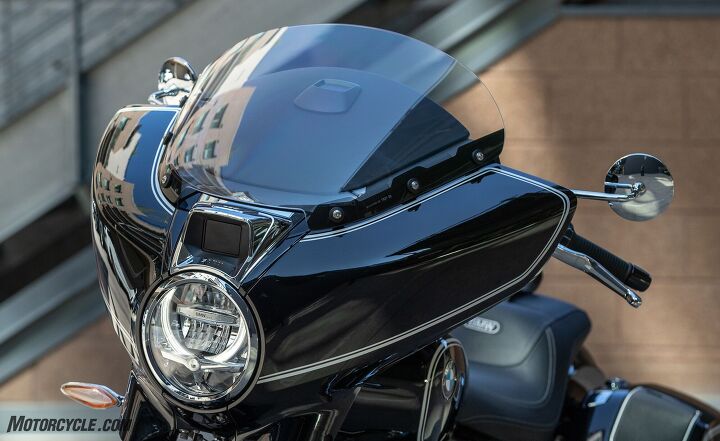
Soon Burns won’t be demanding just cruise control. He’ll want it to be adaptive cruise control. I predict that in 10 years, we’ll laugh at how big the radar unit (directly above the headlight) used to be when adaptive cruise control was released.
Why did I wait so long to write about the 10.25-in. TFT display when I spent so much time looking at it during my ride? Perhaps, I was saving the best for last. The screen really is a sight to behold, and it offered all of the information I needed at any given time save for the fuel gauge and the tachometer, both of which were only glanced at periodically more out of curiosity than need.
Once you’re indoctrinated, the BMW’s menu system is easily manipulated with the control wheel while under way. The TFT is easy to read in all lighting conditions – even with direct light shining on it. The dual trip displays allow me to track my trip both from beginning to end and through each tank of gas. That’s how I discovered that I averaged 59 mph over the entire 1,475 miles. (I’ll leave it to you to figure out how that happened with all the small towns I passed through with 30 mph speed limits.) I really can’t say enough about how nice the screen is, and how its width allows you to view multiple readouts simultaneously, particularly the navigation map alongside the turn-by-turn directions. Which brings us to…
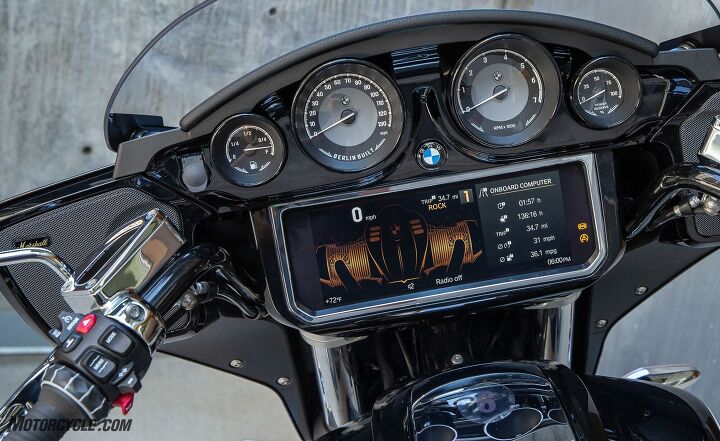
BMW has done such a great job of developing a beautiful screen and an extremely flexible menu navigation system via a control wheel (bottom left), it’s a shame that the navigation app is not ready for prime time.
BMW’s Odd Choice of a Navigation System
I’ll state my thesis right off the bat: A motorcycle company that can design such an intuitive menu system manipulated by a control wheel should be able to integrate that system with both Apple CarPlay and Android Auto. Instead, the engineers give us the BMW Motorrad Connected app, which, in order to work, must always be in the foreground with your phone fully awake. Don’t get me wrong, there are some strokes of brilliance in BMW’s system, like the waterproof phone locker with the USB C port and a fan to keep your phone cool. (Although, one journalist was unable to get his iPhone Plus to fit in the locker with the charging cable attached.) Wireless charging was ruled out because of the heat it generates. How many touring bikes have I ridden over the years in which the storage for charging a phone appeared to be an afterthought? (I remember a pouch hanging inside of a fork-mounted fairing. What bike was that?)
But back to the Connected app. My preparation for my ride back to Los Angeles began in its usual fashion for a touring bike. I massaged a route into shape for each day with Google Maps and then converted the URL for the route into a GPX file for transfer to a navigation system. A reasonably workable solution, and up to the point of getting the information into the Connected app the process is the same as with every bike-based GPS. However, utilizing the app and the navigation system proved to be an occasional challenge.
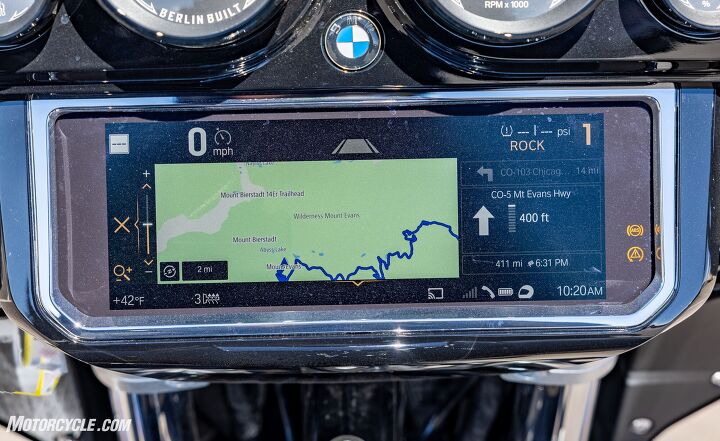
Here’s the view I had on my screen for most of the ride, and when the app was connected, the system was a delight to use.
For the basic operations, like Bluetooth pairing for phone calls and music, the R18B’s process is straightforward. The issue is the connected app. First, it takes a couple of minutes for the system and the phone to completely connect. So, my traveling routine is: start the Connect app, load the route I want to travel, plug the iPhone into the bike, turn on the ignition, wait for the connection process to complete, and finally start the engine. The process was only slightly shortened if the app was already running the route prior to stopping.
Once it’s fully connected to the bike, the display on the TFT is a sight to behold. My preferred setup is to have the map on the left side of the screen and the directions on the right. That way I always know how far it is to the next turn and what the road’s name is. I used this screen setup for my entire ride. Unfortunately, while riding, periodically, for no apparent reason, the system either freezes or disconnects from the phone, leaving me with a flashing icon for the display. If the phone doesn’t reconnect in a minute or two, the only recourse is to pull over and try quitting and restarting the Connect app and possibly the bike, too.
While this disconnection happened on every day of my ride, the first and last days were the worst. Although I can’t prove it, I suspect that heat was part of the issue. During the hours I spent in the desert with the temperature ranging from 104° – 109°F the disconnections were most frequent. But there’s more to the instability.
This isn’t the only issue with the app. What the design team appears to have overlooked is that people like to run more than one app at a time on their smartphones. While I have access to my address book for phone calls and the music stored on my phone, I am out of luck if I want to stream music or listen to podcasts from my favorite app. So, I ended up unpairing my helmet from the entertainment system and pairing it back to my phone. This way I can run the other apps I want to use and the Connected app at the same time. Sort of.
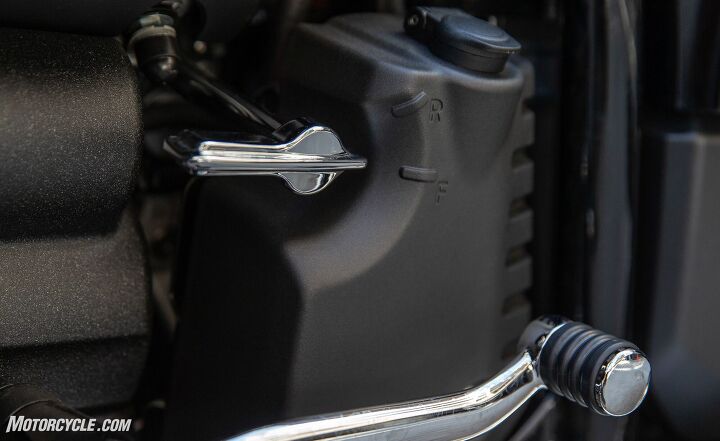
Hey, how about a nice shot of the optional reverse switch right next to the heel shifter?
My final day of riding starts with the map refusing to display. Since the app is still announcing turns (and my trip is a straight shot down I-15 to Los Angeles), I decide to ride without the map. Once the podcast I’m listening to finishes, the map immediately pops up on the screen, and directions start to function normally. So, if heat isn’t responsible for the multiple disconnections with the Connected app, the attempt to run multiple apps simultaneously is.
What BMW appears to have overlooked is that people don’t just use their phones for calls, music, and navigation. Instead of trying to reinvent the wheel, BMW should have spent its time getting their system to work with the CarPlay and Android Auto environments, which would allow people to use their phones as they would in their car. Then the Connected app would work in conjunction with the other apps instead of trying to completely take over the phone. If Honda can make the Gold Wing compatible with Car Play and Android Auto with a less intuitive control system, one would think that BMW is more than capable of doing the same thing. Or is this simply a case of the same “We know better” arrogance that for years forced BMW riders to use three buttons where one switch would work better for turn signals?
The End of the Road
Pulling into my driveway, I’m grateful for my time with the BMW R18B. I’ve gained a depth of understanding of the bike’s strengths and weaknesses that I didn’t have from the one day, 200 mile ride at the introduction. While I can learn a lot about how a bike rides during an intro, a touring bike, because of the complexity of its systems, really demands an extended test. I couldn’t have figured out the intricacies of the Connected app without the seat time, nor would I be able to say that the calculated range from my average of 48.2 mpg is 304 miles.
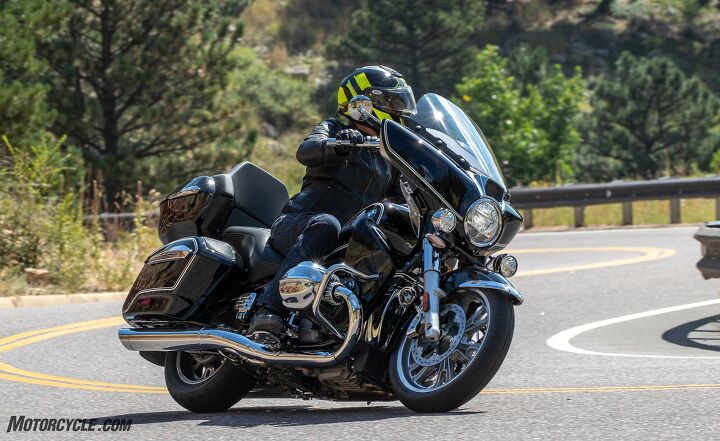
In my short time on the BMW R18 Transcontinental, I found it to be a capable touring companion, but the 64 lb. of extra weight it carries was noticeable in every performance category, making me glad that I’d requested the R18B for my ride home.
As I sit here looking back on the ride, I consider the 2022 BMW R18B to be an extremely capable touring companion with one glaring flaw for the market in the form of the BMW Motorrad App requirement for navigation. Although BMW’s representatives said (and it is fairly obvious) that the Harley-Davidson Street Glide was an inspiration behind the development of the R18B, I don’t think that the bike will steal many sales from the HD faithful. Rather, the R18B and the Transcontinental will attract the bagger-curious and other riders who are attracted to the relaxed cruising-tourer style of riding but were put off by the weight that the Harley name carries in some circles, or perhaps, they simply don’t like the traditional V-Twin configurations offered by Harley, Indian, and the Japanese marques in this riding segment.
If you think you might be interested in either the R18B or the Transcontinental, they are currently arriving in showrooms. The base (and therefore impossible to find) model starts at $22,590. The price, as tested, for the R18B that I rode home is approximately $25,520. It includes the following packages: Premium Light Package ($2,300) and Select Package ($1,275). Then it also received a nice selection of BMW Accessory Roland Sands Designs parts, but no price is available for them: 2-Tone-Black brake fluid expansion tanks, 2-Tone-Black engine housing cover, 2-Tone-Black cylinder head decorative trim, and 2-Tone-Black handlebar end caps.
Go take a look and a ride. Let me know what you think.
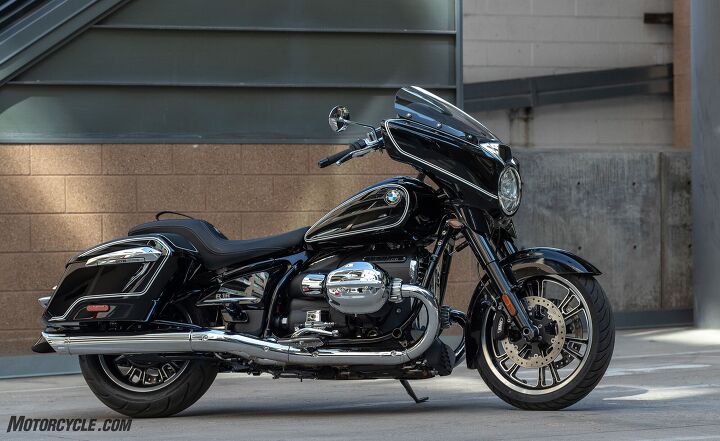
| 2022 BMW R18B | |
| + Highs Cruise-friendly torque curve Great touring range 10.25-in. TFT screen | – Sighs Limited ground clearance Phone-based navigation system not ready for prime time Missing Shift-Assist Pro |
|
In Gear
|
| 2022 BMW R18B (Transcontinental) | |
|---|---|
| MSRP | $22,590 (Base) |
| Engine Type | 1,802cc Air/water-cooled 2-cylinder 4-stroke boxer, OHV, 4 valves per cylinder |
| Bore and Stroke | 107.1 mm x 100.0 mm |
| Compression Ratio | 9.6:1 |
| Rear Wheel Horsepower (claimed) | 91 hp @ 4,750 rpm |
| Torque | 116 lb-ft @ 3,000 rpm |
| Transmission | Constant mesh 6-speed |
| Final Drive | Shaft |
| Front Suspension | Telescopic fork, 49 mm stanchion, 4.7 in. travel |
| Rear Suspension | Cantilever shock, 4.7 in. travel |
| Front Brake | Dual four-piston calipers with full-floating 300mm discs |
| Rear Brake | Four-piston caliper 300 mm disc |
| Front Tire | 120/70 R 19 |
| Rear Tire | 180/65 B 16 |
| Rake/Trail | 27.3 deg/7.2 in |
| Wheelbase | 66.7 in. |
| Seat Height | 28.3 in. |
| Curb Weight (Claimed) | 877 lbs. |
| Fuel Capacity | 6.3 gal. |
| Colors | Black Storm Metallic, Manhattan Metallic Matte (+$500), Option 719 Galaxy Dust/ Titan Silver Metallic (+$2,400) |
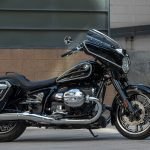
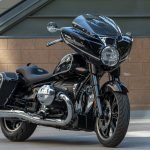
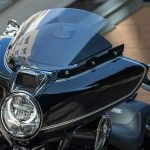
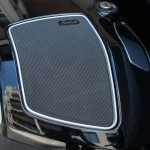
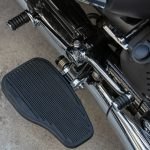
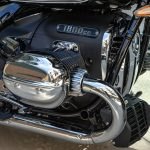
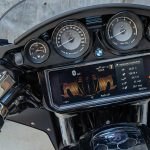
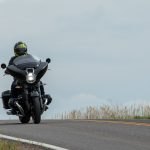
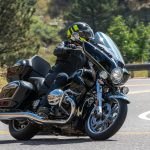
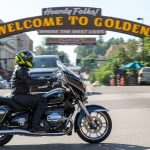
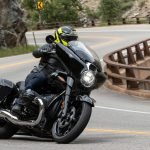
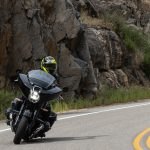
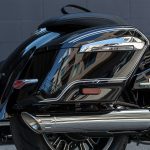
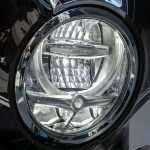
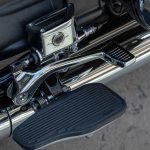
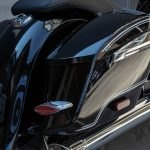
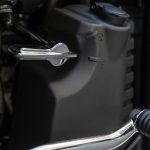
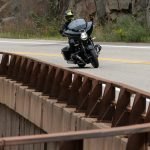
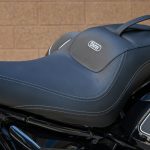
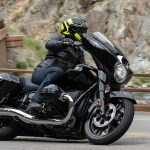
We are committed to finding, researching, and recommending the best products. We earn commissions from purchases you make using the retail links in our product reviews. Learn more about how this works.
Become a Motorcycle.com insider. Get the latest motorcycle news first by subscribing to our newsletter here.
The post 2022 BMW R18B (And R18 Transcontinental) Review – First Ride appeared first on Motorcycle.com.
Copyright
© Motorcycle.com


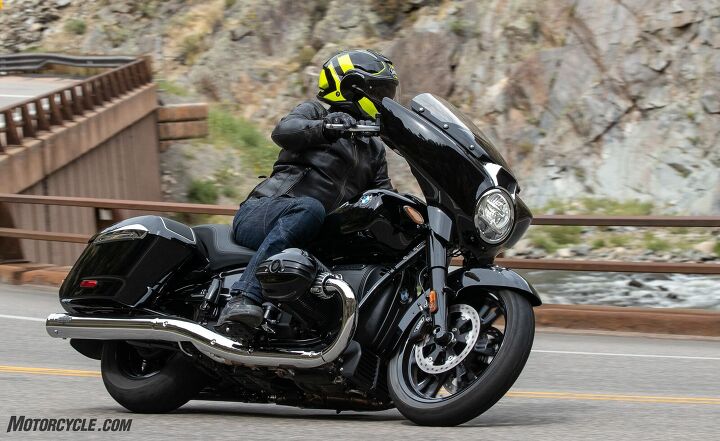 Helmet:
Helmet: